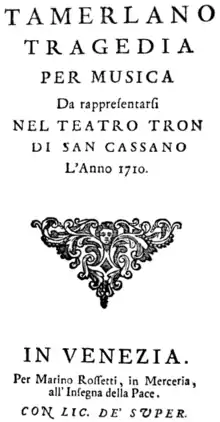Tamerlano (Gasparini opera)
Tamerlano (“Tamerlane”) was a tragic opera in three acts by Francesco Gasparini based on a libretto by Agostino Piovene. It was first performed at the Teatro San Cassiano in Venice on 24 January 1711.[1][Note 1][2]:30


Piovene’s libretto was based on Tamerlan ou La mort de Bajazet by Jacques Pradon (1675).[3] It was Piovene’s second libretto as well as his second collaboration with Gasparini.[4] Tamerlano was Gasparini’s most famous opera, distinguished by the unusual decision to assign the role of Bajazet to a tenor, Giovanni Paita, rather than to a castrato.[1][2]:30
Roles
The opera’s role were Tamerlano (soprano), Bajazet (tenor), Asteria (soprano), Andronico (alto), Irene (soprano), Clearco, Leone and Zaida.[1] The prima donna role was Astoria with nine arias; Bajazet had six, Tamerlano five, while Andronico and Irene had four each.[5]
Plot
The plot concerns a series of dilemmas facing the Turkish sovereign Bajazet who has been defeated and humiliated by Tamerlano, emperor of the Tartars. Tamerlane cannot destroy Bajazet because he loves his daughter Asteria; Bajazet wishes to end the humiliation of his defeat by committing suicide but fears for his daughter’s safety; Asteria would like to reject Tamerlane in favour of Andronico but cannot because of his complicity with Tamerlane; Andronico cannot openly declare his love for Asteria because of the bonds of duty to her father; Irene wants to end her engagement to Tamerlane but is obliged to wait. Finally Asteria, Andronico and Bajazet defy Tamerlane who condemns them all, bringing about a crisis that is resolved only by Bajazet’s suicide.[6] Only a couple of arias remain from the 1711 version.[4]
Later productions and adaptation
In 1714 Tamerlano was staged at the Teatro del Falcone in Genoa.[7] In 1719 Gasparini revised the work for a new production in Reggio Emilia. Now entitled Bajazet, this new version starred tenor Francesco Borosini in the title role.[2]:13
George Frideric Handel certainly studied both of Gasparini’s versions of the opera before creating his own Tamerlano in 1724.[8]
External links
Note
- The Venetian calendar marked the beginning of the year on 1 March, so by this reckoning the first performance (January 1711) was actually in late 1710, as indicated on the frontispiece of the libretto.
References
- "Tamerlano (Gasparini)". opérabaroque.fr. Opéra Baroque. Retrieved 26 November 2019.
- Larry Wolff (30 August 2016). The Singing Turk: Ottoman Power and Operatic Emotions on the European Stage from the Siege of Vienna to the Age of Napoleon. Stanford University Press. ISBN 978-0-8047-9965-2.
- Marie-Élise Palmier-Chatelain (2008). Rêver d’Orient, connaître l’Orient: Visions de l’Orient dans l’art et la littérature britanniques. ENS Editions. p. 172. ISBN 978-2-84788-137-0.
- "Il Tamerlano". opera manager.com. Opera Manager.com. Retrieved 26 November 2019.
- Iain Fenlon; Tim Carter; Nigel Fortune (1995). Con Che Soavità: Studies in Italian Opera, Song, and Dance, 1580-1740. Clarendon Press. p. 278. ISBN 978-0-19-816370-1.
- Markstrom, Kurt. "Tamerlano (libretto by Piovene) ('Tamerlane')". oxfordmusiconline.com. Grove Music Online. Retrieved 26 November 2019.
- Stanley Sadie; Anthony Hicks (1987). Handel, Tercentenary Collection. University Rochester Press. pp. 146–. ISBN 978-0-8357-1833-2.
- Reinhard Strohm (1985-06-20). Essays on Handel and Italian Opera. CUP Archive. p. 84. ISBN 978-0-521-26428-0.